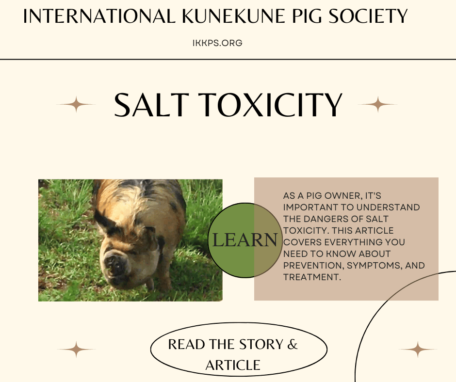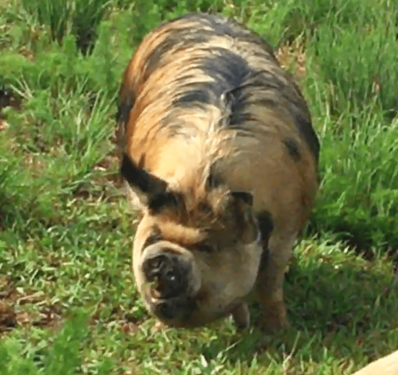
JOIN US
GET OUR KUNEKUNE
NEWSLETTER
New and highly discounted products, fresh and hot stories & useful information

Salt Poisoning in pigs
Salt Toxicity in pigs
Learn about Salt Toxicity in pigs, often called salt poisoning in pigs. Learn what the signs, symptoms, and treatment. Read the story of Pepper, a pig who had salt poisoning and what happened to this special KuneKune pig.
As a pig owner, it's important to understand the dangers of salt toxicity. This article covers everything you need to know about prevention, symptoms, and treatment.
Salt toxicity can be a significant issue for pig owners, as it can lead to a range of health problems and even death. Understanding the signs and symptoms of salt toxicity, as well as how to prevent and treat it, is crucial for the health and well-being of your pigs. Read on to learn more about this important topic. At the end of this, we will share a horrific story with you regarding salt toxicity.
What is salt toxicity in pigs?
Salt toxicity in pigs, also known as salt poisoning, occurs when pigs consume too much salt or do not have enough water, they have taken in. This can happen if they have access to salt blocks or other sources of salt that are not properly regulated. This happens when they fail to drink enough water or have no water. Salt
toxicity can lead to a range of symptoms, including dehydration, vomiting, diarrhea, and even seizures or death in severe cases. It's important for pig owners to be aware of the signs of salt toxicity and take steps to prevent it from occurring.
Causes of salt toxicity in pigs.
Salt toxicity in pigs can be caused by a variety of factors. One common cause is the overconsumption of salt blocks or other sources of salt that are not properly regulated. Pigs do not need salt blocks. At times, owners may not be aware of salt blocks in their pastures or pigs may get into other animals’ salt blocks. Pigs
may also consume excessive amounts of salt if they are fed a diet that is high in salt content. Additionally, salt toxicity can occur if pigs are exposed to saltwater or other sources of salt that are not intended for consumption. It's important for pig owners to monitor their pigs' salt intake and take steps to prevent overconsumption.
Very commonly, pigs will spill over their water sources to make a cool place to lie in. That is why having many fresh sources of water is important when you have pigs. Have a few bowls that hold enough gallons of water to make it heavier so they cannot easily tip them over. Another handy tool is using a kiddie pool
that is filled with water. While they won’t hesitate to climb into those pools, they are also a source of water as well. However, given a choice they
prefer to drink from them and lay in their mud puddles. Likewise, this is a great reason to have mud puddles as they are less likely to dump bowls of water.
Symptoms of salt poisoning in pigs.
The symptoms of salt toxicity in pigs can vary depending on the severity of the condition. In mild cases, pigs may exhibit signs of dehydration, such as increased thirst and decreased urine output. They may also experience vomiting, diarrhea, and lethargy. In more severe cases, pigs may experience seizures, muscle tremors, and even death. It's important for pig owners to be aware of these symptoms and seek veterinary care immediately if they suspect their pig may be suffering from salt toxicity.
Treatment for salt toxicity in pigs.
The treatment for salt toxicity in pigs depends on the severity of the condition. In mild cases, the pig may simply need to be given access to fresh water and monitored closely. However, it is important to slowly rehydrate them to not shock their systems.
In more severe cases, the pig may need to be hospitalized and given intravenous fluids to help flush the excess salt from their system. In extreme cases, the pig may require emergency treatment to prevent seizures and other life-threatening complications. It's important for pig owners to work closely with their veterinarian to develop a treatment plan that is tailored to their pig's specific needs.
Prevention of salt toxicity in pigs.
The best way to prevent salt toxicity in pigs is to ensure that they always have access to fresh, clean water. Pigs should also be fed a balanced diet that is appropriate for their age and weight. It's important to avoid feeding pigs table scraps or other foods that are high in salt. Additionally, pig owners should monitor their pigs closely for signs of salt toxicity and seek veterinary care immediately if they suspect their pig may be affected. Regular check-ups with a veterinarian can also help to identify and address any potential health issues before they become serious.
The best time to have an experienced vet is before you need them. Please make sure that you keep your vet’s phone number in a place where you can easily find it in case of an emergency. See additional resources at the end.
The Story of Pepper - a special gilt who had salt toxicity.

Pepper was a beautiful gilt, and she was friendly and outgoing. She was sold to someone in another state for breeding. One day, I received a call from the new owners, they had her for about 2 months at this point. Pepper was standing in a corner and not moving much of the day. Well since she had already had time to settle in, this was not a concern. She was not acting funny just standing there in what seemed like a daze.
Later in the day, she was acting confused and drunk. She was breathing rapidly and was not getting up. The owner had no vet to consult with. I drove to her home and picked her up, which was not an easy task as she was about 125 pounds and about 9 months old. We got her loaded and I brought her home and put her in an empty farrowing quarter so that she could be closely monitored.
All the right Questions
I began to watch her and knew that it was severe whatever was going on with her. I had asked the owner all the right questions. What had she eaten? Is there anything in your pasture that is toxic? Any salt blocks? Did she have fresh water? Well, after all the details came out and the owner walked every part of his pasture, he found an old salt block left over from cattle. There we have it! We know the issue now!
Time for action
I immediately called the vet for help to save this little gilt’s life. Having a good vet is vital. I happened to have a fabulous vet. Scheduled for just a few hours away to come for a farm call, gave me hope. In the meantime, I got busy getting her settled and I happened to have an IV bag available and all the tubes and needles to go along with it. I gave her sub-Q fluids to wait for the vet. Furthermore, I would let a big bubble of IV fluids slowly absorb into her system. Offering her a small amount of fresh water and an electrolyte solution as well. She was spinning around in circles and when she stopped, she would stand in the corner again. It was no easy feat to keep her from hurting herself.
The vet came and he gave her the complex Vitamin B and a few other things to try. He also brought me two more bags of IV solution. (Having worked for a vet for 5 years, I could easily administer the fluids Sub Q.) So, he left me with several medications and best wishes. He told me it was highly likely she would pass away or even suffer brain damage. He stated he would be surprised if she was not gone by the morning. Well, he did not know how determined we both were!
My responsibility
Being a dedicated breeder, I knew that I would climb any mountain to save her. After all, if I brought her into the world, she was my responsibility. Likewise, I was the type of breeder who had to try everything within my power to save any animal. I continued her on fluids and medication every few hours and would sit with her in the farrowing quarters and at times hold her head in my lap and talk soothingly to her.
I cannot say this was easy for weeks upon weeks. I got up with her in the middle of the night and monitored her consistently. My bond with her was extraordinarily strong at this point. I sat and held the needle for her IV fluids and had to remove it when she spun in circles. It was a tough time for both of us.
How the Story Ends!
While some stories do not have a successful conclusion, I am so happy to report this one did. Her willingness to receive help and my determination not to lose her, we succeeded in getting her through this. It took approximately 5 weeks to get her back to normal but, normal again, she did! Now the owner checked in on her several times during this time.
Now came the time for her to go back home. Well, I just could not let her and did not know if there would be permanent damage from this. So, I offered him another female so that I could keep her myself and keep a close eye on her. Since I have never encountered this myself, I wanted to monitor and deemed her to remain with me as a grazing pig.
Twelve months later, she had a complete recovery and there was no damage to her at all. She was acting just like any other pig and was later able to breed. This story could have gone horribly wrong but, in this case, a happy conclusion!
In conclusion
If you are new to your farm, take a moment and walk every single inch of it that may have had farm animals on it. Take careful care to provide fresh water daily. Make sure they have multiple sources of water. Use heavy water dishes, kiddie pools, sand boxes and mud puddles. Salt toxicity in pigs can be easily prevented.
Additional Resources and Learning on pig salt poisoning
Related Articles of Interest
Registry Office
17500 Hamilton Arms Court Dewitt, VA 23840